|
LANDMARK EVENTS II
TARZAN IS THE OTHER OF MINISTER'S
2 HEROES
THE COMMERCIAL APPEAL
Memphis, Tenn.,
Sunday, December 9, 1979
If Dr. Darrell C. Richardson could be transformed
into a talking doll, his first words would probably be, "Me Tarzan, you
Jane."
The Memphian, acknowledged as the world's greatest authority on the
writings of Edgar Rice Burroughs, made Tarzan his hero even before he picked
Jesus as a permanent life-model. "That's the first declaration I made to
the athletes at Furman College (in Greenville, S.C.) after my arrival there
on scholarship. Fellows, I told them, I have tow heroes -- Tarzan and Jesus
of Nazareth."
After spending a lifetime getting better acquainted with both, he's
still making the same declaration, both in his three secular lives (archeologist,
author and dedicated collector) and form the pulpit.
"Tarzan was a man without fear. That's the reason he's my hero --
along with the fact that he didn't have to wear a tie.
"But in actuality, the character created by Burroughs as the king
of the jungle was much deeper. Burroughs has never been acknowledged as
the great satirist he was -- I consider him on a par with Jonathon Swift.
But what are the Tarzan books except a satirization of society as we know
it?
"He fulfilled my boyhood ideals of what was important: He was a revolutionary,
which I was; he was an ecologist, which I was, long before I left Flat
River, Mo."
Dr. Richardson is so saturated with "Tarzanosophy," it is a simple
matter to picture him as the real-life manifestation of Burroughs' famous
jungle man. The retired Baptist minister, editor of publications for the
Brotherhood Commission of the Southern Baptist Convention, no longer has
the litheness of youth. But he's still a big, strong man, impressive in
the bush clothes he wears.
His introduction to his hero came early. "I was 8 years old when
I saw my first Tarzan book. A schoolmate across the aisle from me was reading
Beasts of Tarzan. I caught a glimpse of one illustration and that was it.
"The book he had was a Grosset and Dunlap reprint which sold at the
time for 75 cents. Well, the only money I had was 15 cents a day for lunch,
but it didn't take me long to figure out that if I went without lunch I
could buy one book a week. My parents never knew why I was eating two or
three suppers every night.
"I traded my marbles for books and then my scooter. When I got to
high school, I worked and saved the money to make a trip to Kansas City,
with an extra $20 to buy an overcoat. But I happened across an out-of-the-way
book store and instead of an overcoat, I went home with 15 Burroughs first
editions to keep me warm.
"Let me tell you about those out-of-the-way bookstores. You can put
me down anywhere in the world, and I'll just happen across one immediately.
My instinct directs my feet."
Dr. Richardson started a correspondence with Burroughs while he was
in junior high school. Since then he has made many trips to Tarzana, Calif.,
originally Burroughs' private estate. He has become friends with everybody
connected with Burroughs or his writings: Publishers, illustrators, actors
and collectors all over the world.
But he never met Burroughs. The reason was, he was getting on with
his own life: Degrees in archaeology and journalism, and then to the seminary
to prepare for the ministry. And he was also beginning to write ; he found
a market in the pulp adventure magazines. He has had 41 books published
under the pen name D. Coleman Rich, many of them science and space fiction.
But he never forgets his other hero. His latest book, published under
his own name is "The Christian Facing a World of Change."
Dr. Richardson served as pastor of several Baptist churches, as an
Army chaplain in Korea and later in the Army Reserve, and as an archeologist
in the Mideast and African digs. He has earned four masters degrees and
is working on his second doctorate. "And that doesn't matter a hill of
beans," he said Degrees don't make you any better, but you learn a lot."
His usual educational background has given him some extra clout in
carrying the banner for Burroughs and other adventure story writers. "The
literary people, librarians and English teachers have absolutely scorned
these writers," he said. "They have perpetuated the claim that nobody was
interested in such imaginings except the unlettered, because of their own
narrow-mindedness about his financial success.
"But there's been some breakthrough. Not along ago, an Oxford professor
said that Burroughs' vivid terse, descriptive writing in Princess of Mars
was on a par with the best of H.G. Wells.
"And certainly Burroughs has been one of the most appreciated authors
in all walks of life. With the possible exception of Sherlock Holmes, Tarzan
has been the most widely-read character in the world. That's a strong statement,
but I'll stand behind it.
Dr. Richardson shares the honor of "best collection" with nine other
Burroughs Bibliophiles (the name of the collectors' international organization),
but he has the most foreign printings of Tarzan books. He said, "Do you
believe there are 52 titles in Arabic that were published in Cairo and
22 in Hebrew?"
Dr. Richardson ranks tops in another area. "All of the Burroughs
stories were published serially by magazines before they became books.
And I have every magazine issue in which a story he wrote was published
-- including some that never became books." He also has some unpublished
manuscripts.
He is also noted for having the finest collection of old pulps in
the world -- 19,000. I am often consulted by the Library of Congress because
it doesn't have nearly the volume of material I have." And his collection
of 29,000 other books includes early boy's fiction, Western, space and
science fiction.
"I mean, who needs 48,000 books?" he said, laughing, before adding,
"Except the world of the future. So, I'll keep on going on treasure hunts.
I was convinced a long time ago that my instinct as a boy was mighty good.
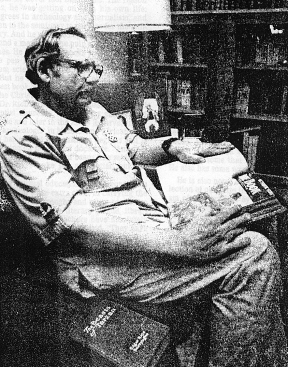
Dr. Darrell C. Richardson
never tires of reading about Tarzan
RETIRED MINISTER SWINGS
WITH EASE
FROM LORD TO LORD OF THE JUNGLE
Well-Read Minister Finds
No Need For Censorship
by John Beifuss
COMMERCIAL APPEAL
Memphis, Tenn., Friday Morning,
March 30, 1984
George Orwell may be getting all the press in 1984, but
for Dr. Darrell C. Richardson, Edgar Rice Burroughs is the author of the
year -- or any year.
Burroughs was the creator of Tarzan of the Apes and numerous other
heroes of primeval jungles and alien worlds.
Dr. Richardson is the creator of his own alien world, filled with
relics of Burroughs' Venus and Mars (or Barsoom as its green four-armed
natives call it), Pellucidar (the land at the Earth's core) and the mysterious
Africa that existed only in the author's imagination.
I do have the largest Burroughs collection of anybody in the entire
world," Dr. Richardson said, "It includes so many thousands of items that
I really have lost count."
Dr. Richardson is an author, archeologist and Southern Baptist minister.
HOw a man of the cloth became so interested in the man of the loincloth
is something that has perplexed his fellow clerics for years. Dr. Richardson
is as likely to say he's going to curl up with a good book as the Good
Book.
"From anybody's standpoint, these hobbies are kind of oddball for
a Baptist minister. But then, I've never been a run-of-the-mill human being."
Dr. Richardson says Tarzan is "today the most popular character of
fiction in the history of the literature on this planet.
"I'm basing that on the whole area of the communications media,"
he said. "Long before such things as 'Star Wars' hit almost the entire
gamut of exploitation idea, this is true of Tarzan. A pretty close rival
to him is Sherlock Holmes."
Of course, the Tarzan of Burroughs' works was a far jungle-cry from
the primitive ape man of Hollywood and vine fame, as epitomized by the
late Johnny Weissmuller. The author's Jungle Lord was also an English Lord,
self-educated and multilingual. At the same time, he was capable of a savage
fury that would have made Buster Crabbe blanch, often using his teeth to
tear open the throats of his enemies.
The Ape Man first appeared in All-Story Magazine in 1912. Dr. Richardson
has copies of that issue, and all other book and magazine appearances of
Burroughs' works in almost every language -- even editions smuggled
from a predetente Red China. He has mint-condition copies of the first
edition Tarzan novel that are valued at $3,700 each.
Dr. Richardson's ERB collection, however, is just the tip of his
iceberg of memorabilia. HIs collections are truly -- to quote the title
of one pulp mag -- "Amazing."
He estimates he owns 29,000 hardcover books, 19,000 pulp magazines
14,000 movie items, 8,000 paperbacks, 6,000 Westerns (he says "Western
Americana" may be his main interest) and 1,000 mysteries. He has first
editions of all works by H. Rider Haggard, A.E. van Vogt, Robert Heinlein
and other authors. He doesn't collect comics, but has managed to acquire
about 8,000 of them, anyway.
"I decided many years ago to put all my liquor and tobacco money
into books, and look what happened."
Like the Blob, his collection continues to consume his home. He has
built two back-yard garages, one of which was completed a few weeks ago,
for the overflow of some 10,000 items -- "but that's just a drop in the
bucket."
Perhaps the most fabulous part of the collection is the more than
300 original artworks, originally commissioned for the covers of books
and pulp magazines. Many depict scenes of savage combat.
He says, "My study of history has shown me man hasn't changed
that much. I'm sorry to say."
Dr. Richardson owns paintings by J. Allen St. John, who created covers
for the firs editions of many Burroughs works; Frank R. Paul, the "father"
of fantasy pulp art; John Coleman Burroughs, ERB's son; Frank Frazetta,
whose work is the most expensive and sought-after of active fantasy artists;
and even N. C. Wyeth, who did a cover for an early edition of "The Return
of Tarzan."
Dr. Richardson bought his first St. John in 1947 -- for $7.50. "It's
very garish. He wanted to see if he could get by with painting vermilion
rocks and yellow sky and lots of purple."
In the pulp era, the magazine company would own all rights to the
art. "The artist in those years never saw it again. It was not for posterity
or my collection."
Dr. Richardson's love for fantastic tales of lost kingdoms and races
complements his interest in archeology and anthropology. He has a wide
collection of textbooks.
"I can read them with the same avid interest I'd read a really fantastic,
wild story of adventure, and love 'em both. Very few of my scholar friends
can do that. Somehow they've lost their spirit of adventure.
"I always put first things first, and that's fun. Though I have four
master's degrees and two doctor's degrees, I've never allowed that to interfere
with my life particularly," he explains.
Unlike some ministers, Dr. Richardson has never been one to favor
extreme censorship measures.
"Even though I'm a retired Baptist preacher, I have truly catholic
tastes. I've read all my life, since I was 5 years old and read every day
of my life. My tow sons were brought up in a pastor's home, and brought
up to read literally anything they wanted to read.
"I've always been a practicing Christian. You can't pick and choose
parts of the Bible. However, you don't have to let someone else do your
interpreting for you, either.
Dr. Richardson has traveled around the world, and his interests have
enabled him to meet such people as Weissmuller, Frazetta and the Burroughs
family, among others.
"I've had such great and wonderful adventures," he says, "that my
life is so rich and full, if I would die tomorrow I would be satisfied."
Why that sounds like something Tarzan might say.
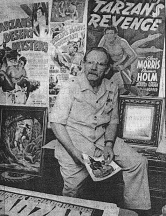
Dr. Darrell C. Richardson
with part of his collection
RELATED ARTICLE:
For the latest in Tarzan movies, turn to the review on Page C2.
* * * * *
Continued from Page C1: Swinging through world's largest Burroughs
collection.
JANE GONE, BOY GONE, BUT
TARZAN NOBLY BACK
by Thomas Fox
THE COMMERCIAL APPEAL
Memphis, Tenn., Friday, March
30, 1984
Those heavily exposed to movie versions of Tarzan might
find "Greystoke: The Legend of Tarzan, Lord of the Apes," an unwelcome
swerve from the tradition of jungle adventure.
The standard line of introduction, "Me Tarzan, you Jane," is
nowhere to be heard. This Tarzan does not wrestle rubber crocodiles or
parade around atop a pet elephant; his jungle bellow has no music; there
is no cute Cheetah and no Boy; about half the film unfolds in Scotland.
The hero in this version of Edgar Rice Burroughs' jungle myth isn't
even called Tarzan. By the time he has a name at all, it is John Clayton
of the Greystoke line.
While this is a more adult and serious-minded Tarzan movie than any
we have seen before, there are a few points that almost everyone will recognize.
Tarzan's parents are shipwrecked on the African coast, and soon after the
tot is born Mom drifts off in a fever and Pop is killed by rampaging apes
-- or, more accurately, actors in ape costume.
The boy is taken into the viny wilds and, with the help of a knife
and evolution, grows up to become leader of the simian band. Just as he
comes of age -- old enough for Christopher Lambert to step into the role
-- along blunders an English expedition, with guns blazing in an orgy of
"sport and blood, the stuff of life."
With a sympathetic Belgian (Ian Holm) as his guide and protector,
Tarzan is shipped to the ancestral spread in Scotland, there to become
the
joy of his grandfather's last days. Ralph Richardson, in his final film,
plays the elder Greystoke as a combination of creeping senility and endless
understanding.
Richardson's is an important contribution, bringing a touch of humanity
and humor to the stifling atmosphere of aristocratic propriety.
When his unrefined grandson picks up his bowl and drinks his soup
in front of guests, Richardson abandons his spoon and slurps along. In
their brief time together he tries to pass on as much as he can to the
young man caught in an unsure transition from nature to civilization.
Land is everything, he advises while looking over his own square
miles, and nothing is more important than keeping everything you are born
to.
There is more sociology than sweat in the film's second half, as
Lambert is exposed to the realities of society while still hearing the
echo of the jungle, where life was little more than squabbles within his
ape family, feasts of termites and an occasional fight to the death.
There has to be a Jane, of course, and here she is an American (Andie
MacDowell) who finds the jungle visitor an irresistible hunk of intelligence,
good looks and innocently primitive ways. What young woman of proper breeding
could refuse a wealthy suitor who chills her with cat growls and comes
creeping into her bed on all fours?
While Hollywood tradition has reduced Tarzan to the level of a B-movie
superman, "Greystoke" (at the Hickory Ridge and Quartet) is an expensive
and intelligent recasting directed by Hugh Hudson ("Chariots of Fire").
ONce past the gore of the jungle, it turns away from the call of the comic
book to concentrate on Tarzan as a sympathetic and sensitive figure in
the tussle between the nobility of life in the wild and civilization's
smug opinion of its own virtues.
HE'S APE OVER THE APE MAN
by Lloyd Dinkins
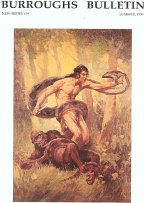
Among fictional characters, Tarzan probably is the biggest
swinger of all. And the Rev. Darrell C. Richardson of Memphis is the world's
foremost authority on the Ape Man and his creator.
In Dr. Richardson's neat home at 899 Stonewall are almost 12,000
books and 14,000 pulp magazines to make up the world's best collection
of its type. Tarzan is represented in rare first editions in every major
language of the world.
"I started in the second grade saving all my money to buy books.
I've had a lifelong interest in books of all kinds. This developed into
my own private library of almost 12,000 books representing all areas of
knowledge.
"I had read every book in the library at my home town, Flat River,
Mo., but I got interested in Tarzan when I was in the third grade. A boy
across the aisle from me had a copy of The Beasts of Tarzan, with a big
geography book in front of it, sneak-reading it in class. I saw some of
those great old J. Allen St. John illustrations. The one I saw was Tarzan
leaping down from a tree on top of a panther's back with his knife raised,
saving the life of an ape. That was right down my alley."
And ever since that day, Dr. Richardson, an ordained Baptist minister,
former pastor, former Army chaplain, active leader of the Boy Scout movement
and prolific writer of science fiction books and stories.
He also has the best collection in the solar system of the paintings
and drawings of the late J. Allen St. John, who illustrated most of the
Tarzan stories when they first appeared in magazines and books.
Edgar Rice Burroughs brought Tarzan to life in 1912. Dr. Richardson
says the continuing popularity of Tarzan stories is a phenomenon "frightening
to publishers." Several times each year, some publisher brings out a reprint
of one of the 24 Tarzan books, which now have been published in 58 languages.
Dr. Richardson has every Burroughs book, including all of the "Venus"
series, the books about the planet Mars and the Pellucidar books that chronicle
a hidden world at the earth's core, as well as the better-remembered Tarzan
series.
"I have at least one copy of each, all in first editions, and in
most cases, in excellent condition. Many of the books I have are the very
best of some 20-30 copies that have passed through my hands. So the ones
I have kept are the best among many identical books.
"In addition, I have some 2,000 Tarzan and other Burroughs books
in foreign editions. There is a complete set in Chinese, for example, and
the first editions in German, Greek, Dutch, Turkish, Finnish, Arabic and
about 30 other languages.
"I have personally picked up many of the foreign editions in Turkey,
through Africa, in Europe and the Arabic world. In fact, of the 24 books
Burroughs wrote about Tarzan, I have more than 50 titles in Arabic, because
publishers over there plagiarized the character of Tarzan and invented
new stories around him, stories that Burroughs himself never heard of."
In that regard, the "outlaw" publishers treated Tarzan as Hollywood
treated him, but at least the movie producers paid Burroughs who pocketed
from $100,000 to a million dollars for every Tarzan film.
"The first two movies, which starred Elmo Lincoln in 1918 and 1921,
were fairly faithful to the Burroughs character. After that, Hollywood
swung out on its own," Dr. Richardson says.
Vine-swinging for instance, is a Hollywood invention. Nowhere in
the Burroughs books does Tarzan actually swing on a vine. "And even as
a small child, Tarzan of the books is far too intelligent and educated
ever to saw, 'Me Tarzan, You Jane,'" the collector says.
But unfortunately, the movie version is the best known, at least
in the United States.
"Of course, Tarzan has been communicated in just about every medium
there is. These include books, magazines, recordings, newspapers, comic
strips and comic books, television and radio. I believe Tarzan has been
in more kinds of media and exposed to more people than any other single
character ever known. I suppose Sherlock Holms runs about equal, or maybe
just behind Tarzan.
"And when Tarzan became the character for a newspaper comic strip,
he became the forerunner of ALL adventure strips. All the other adventure
series came along after Tarzan in the funnies," Dr. Richardson says.
As an international authority on Edgar Rice Burroughs and Tarzan,
Dr. Richardson is called upon by many editors for articles for books, collectors'
directories and magazines. Many of these are written under his pen name,
D. Coleman Rich. (His regular job as an editor for the Baptist Brotherhood
Commission also calls on his writing talents).
The associated material in the Richardson collection includes a complete
print of the first Tarzan movie, "Tarzan of the Apes," in addition to the
St. John illustrations and samples of the more than 2,000 commercial products
and gadgets bearing the Tarzan trade mark.
At least two towns, Tarzana, Calif., and Tarzan, Texas, were named
after the jungle king, and there have been sweatshirts, toys and countless
souvenir items labeled Tarzan.
Why do readers like Tarzan? Dr. Richardson says: "I think I know.
I think Mr. Burroughs knew. Before he died, Mr. Burroughs said, 'We like
to picture ourselves as roaming free, the lords of our selves and of our
world. In other words, we would each like to be Tarzan. At least I would.
I admit it.'"
The Ape Man led an exemplary life, too, Dr. Richardson likes to point
out.
"Tarzan would never smoke a cigaret, swear or get into an immoral
situation. In fact, Mr. Burroughs' contracts with the movie producers set
out those conditions. And Tarzan had a social conscience.
"Long before anyone else was worried about it, Mr. Burroughs had
Tarzan practicing conservation and protection of the environment. Mr. Burroughs
also predicted in his books the crowded, polluted cities of today.
"And although Tarzan for many years had no literary recognition,
I now have an English textbook for high schools in which the textbook authors
outline and analyze 'Tarzan of the Apes,' putting him alongside the characters
of Kipling and other literary figures."
For anyone whose Tarzan knowledge is limited to the Saturday afternoon
escapades of Johnny Weissmuller, it is enlightening to hear Dr. Richardson
extoll Tarzan's virtues. Tarzan is brilliant, cultured, self-educated and
at home with the beasts of the jungle.
He is a fighter for right, healthy and has an uncanny ability to
judge the never-ending procession of heroes and villains who trek through
his forest domain. Even though they all wear white pith helmets, Tarzan
can spot the bad guys.
"He's no chimp.
|


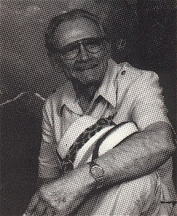
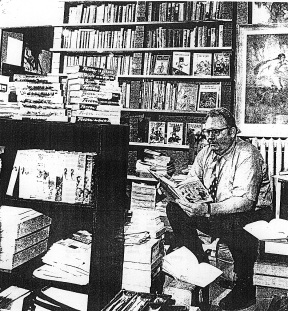
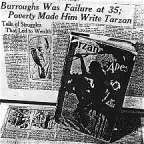
![]()
![]()
![]()
